

|
Drawn by Lot Fest Noz


|
Roger Poitevin takes us to a unique night of music and dancing in Brittany.

October 5th 2002
Click on the ear to hear the performances in your Real Audio player. If you want to come back to a particular pieces, you can use the drop down menu in your player to find a specific performance described below.
Dastum (Breton word meaning to gather, to collect) is an association which collects and highlights the cultural heritage of Brittany. It is organized as a federation of independent local agencies. Dastum Bro Dreger, based in Lannion, organized the fest-noz from which this music is presented.
Dastum Bro Dreger has been organizing some large events every year beginning in the mid-eighties, and although it has been enjoyable, the musicians wanted more fun and something even more challenging. In January of 1998, someone came up with the idea to invite a group of approximately 80 musicians and put everyone's name into a hat, and draw out bands of four from the hat.
The idea was an immediate success, although it is a lot of work to set everything up. The board of Dastum Bro Dreger decided to continue this event every two years. At the end of August 2002, a mass mailing was sent out to all of the traditional musicians of the Trégor area. Musicians answered quite quickly and at the beginning of September the drawing ceremony was set up in Dastum Bro Dreger office in Lannion.
76 musicians were registered, and each name and instrument carefully written on a ticket. The tickets were placed into a bag and shuffled, and the innocent hand of a child drew them 4 by 4 on the 7th of September 2002 to get 19 bands. Of course the rank was the same as the drawing�...first drawn = first on stage. We had 4 weeks to come up with a repertoire of tunes, and we eventually chose original tunes and traditional tunes, and even a combination of original and traditional!
On D day, all the musicians showed up early and roamed around the communal dance hall of Prat city where the fest-noz was scheduled. Some of them were doing a last emergency rehearsal. The others were setting up the bar and testing the quality of the different beers� Everyones' duties were posted. Some people had to man the bar, sell tickets, record the music, or just had general duties. The evening began with the most important event which all of us were looking forward to! The country style buffet for the musicians!! Bread, pâté, salami, summer sausage, chips, cheese and wine were displayed on the long table, and everyone had plenty to eat and drink. At 8 PM the first band readied itself behind the stage to have his picture taken by Gilbert Le Gall. The third Dastum drawn by lot fest-noz began!!!
Dancers had been anxiously anticipating this event for weeks and weeks, and were standing on the sidelines waiting for the first chords to step into the circle. Dances played came from everywhere in Brittany, although northern Brittany was the most important area presented.
The real challenge for me is to attempt to share with you a moment which was sheer pleasure and incredible joy for the musicians. For this presentation, I had to select some of the performances presented that night, and it was difficult and heartbreaking to have to leave out some of the musicians' performances. I hope the ones not chosen for the program will forgive me. It was not the quality of their performances which was the criterion but more obviously the length of the dances or the too poor quality of the recording.
Six bands out of nineteen were selected for this presentation, and they play five different dances (I'll tell you later where the trick is). Many of the musicians who participated that evening have listened to the bands chosen, and the opinion of all the musicians participating in the session who listened to the selection is that it depicts quite well the atmosphere of the evening. There were at least 800 people dancing during the evening, which began at approximately 8 p.m. (well a little later�) and finished at 3:30 a.m. Sweeping the ballroom and kicking out the leftover stragglers and drunks made it really over a little before 6 a.m.
First band to appear was a band of 3 accordionists and 1 drummer. Guess whose eardrums burst?
In order of drawing (and the order you hear them in here) :
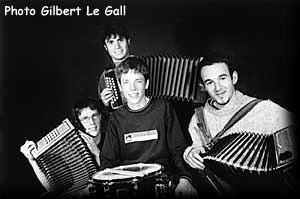 Alan Tassin (diato. accordion), Maelan Joubin (diato. accordion), Daniel Lawson (diato. accordion), Romain Pansar (drums).
Alan Tassin (diato. accordion), Maelan Joubin (diato. accordion), Daniel Lawson (diato. accordion), Romain Pansar (drums).
All of them are very young (either in highschool or in college) and talented musicians practicing from the age of 7 to 10 years old. They play a set of 6 beats ridées, which is a dance from Eastern Brittany -- the part of Brittany speaking Gallo language, and to start the evening they really set the dancers on fire�
|
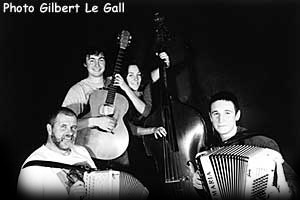 The second set of dances is played by a band which wanted to give everyone a lot of laughs, so they scornfully added fancy lyrics in French on a traditional tune and had wonderful success playing a "belly to belly" modern dance: a set of Polkas plinn from the area of Bourbriac and Sainte Trephine. They were Delphine Quenderf (double-bass,vocals), Samuel Le Féon (chroma. accordion), Erwan Hémeury (guitar, vocals), Roger Poitevin (diato. accordion)
The second set of dances is played by a band which wanted to give everyone a lot of laughs, so they scornfully added fancy lyrics in French on a traditional tune and had wonderful success playing a "belly to belly" modern dance: a set of Polkas plinn from the area of Bourbriac and Sainte Trephine. They were Delphine Quenderf (double-bass,vocals), Samuel Le Féon (chroma. accordion), Erwan Hémeury (guitar, vocals), Roger Poitevin (diato. accordion)
|
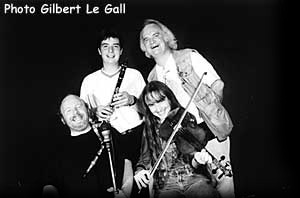 The third band is playing and singing a full set of Plinn dance. This dance is made of three parts which are inseparable. The first tune is often called "tamm kentañ" (first part) or "ton simpl" (simple tune) as the length of the first musical phrase is equal to the length of the second one. The middle part is called the "bal" and is slower as its purpose is to let the dancers get some rest. The third part called "tamm diwhezañ" (last part) is a "ton doubl" which means the second musical phrase is twice longer than the first one. Their names were Thierry Barbier (veuze pipe,Breton old pipe), Anne Bocher (fiddle), Mathieu Blondet (clarinet), Marc Féron (vocals)
The third band is playing and singing a full set of Plinn dance. This dance is made of three parts which are inseparable. The first tune is often called "tamm kentañ" (first part) or "ton simpl" (simple tune) as the length of the first musical phrase is equal to the length of the second one. The middle part is called the "bal" and is slower as its purpose is to let the dancers get some rest. The third part called "tamm diwhezañ" (last part) is a "ton doubl" which means the second musical phrase is twice longer than the first one. Their names were Thierry Barbier (veuze pipe,Breton old pipe), Anne Bocher (fiddle), Mathieu Blondet (clarinet), Marc Féron (vocals)
|
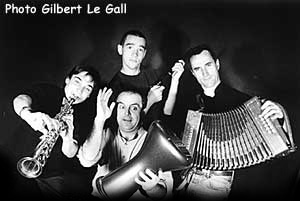 The fourth and fifth bands shared the set of gavotte dances (that's why there are five dances and six bands). A set of gavottes is built on the same scheme as a set of plinn dances, ton simpl, bal (often called "tamm kreiz" = "middle part) and ton doubl. The two first parts are played by a terrific band including one of the best Breton flute players and undoubtedly one of the best bombarde and biniou makers from Brittany. Jean-Luc Thomas (Irish wooden flute), Benjamin Toinen (congas), Gilles Léhart (saxophone), Youen Bodros (diato. accordion)
The fourth and fifth bands shared the set of gavotte dances (that's why there are five dances and six bands). A set of gavottes is built on the same scheme as a set of plinn dances, ton simpl, bal (often called "tamm kreiz" = "middle part) and ton doubl. The two first parts are played by a terrific band including one of the best Breton flute players and undoubtedly one of the best bombarde and biniou makers from Brittany. Jean-Luc Thomas (Irish wooden flute), Benjamin Toinen (congas), Gilles Léhart (saxophone), Youen Bodros (diato. accordion)
|
To finish this set the "ton doubl" was played by the only five member band of the evening. (It's been told the accordionist invited Marie-Laure because he wasn't really sure of his own skill at this time of the night� héhéhé!!!)
This gang of funny guys and gals was made of Jaouen Le Goïc (diato. accordion) Rozenn Derriennic (saxophone), Stéphane Foll (Breton old pipe/bombarde), Pierre Poitevin (Irish wooden flute), guest : Marie-Laure Le Duc (fiddle)
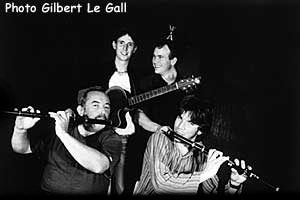 The last band of the evening was another twist of fate. It was originally supposed to be made up of three flute players and one guitarist, and they played their first tune like that, but the recording was not of good enough quality to be used so they took back their primary instruments to offer us this set of 8 beats laridés which was a great ending dance for a terrific evening!
The last band of the evening was another twist of fate. It was originally supposed to be made up of three flute players and one guitarist, and they played their first tune like that, but the recording was not of good enough quality to be used so they took back their primary instruments to offer us this set of 8 beats laridés which was a great ending dance for a terrific evening!
These excellent musicians were : Youen Péron (Breton old pipe), Christophe Marquier (bombarde), Pascal Créac'h (Irish wooden flute), Pierre Quéré (guitar)
|
It was a fine and fabulous evening for all � both the dancers and musicians, and we all look forward to the next drawn by lot fest-noz! Hope you can come! - Roger Poitevin
Roger Poitevin would like to acknowledge the cheerful help of Kay Hickman for proofreading, February 26, 2003.
Links:
Dastum Association
You can hear some performances by Roger and Yannick Le Bras from the 2001 RootsWorld Free Reed Festival
Vist Roger's web site
All audio and images are ©2002 and 2003 by the artists. No reproduction in any form may be made with out specific permission form the artists.
Presentation ©2003 RootsWorld.